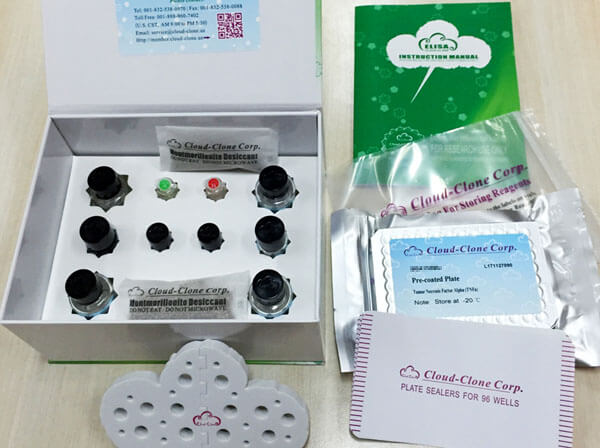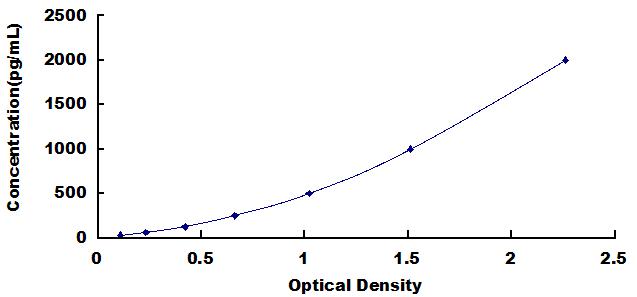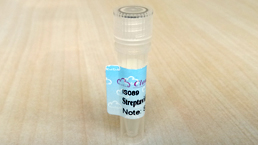ELISA Kit for Procollagen III N-Terminal Propeptide (PIIINP) 

P3NP; N-Propeptide Of Type III Procollagen; Procollagen III Amino Terminal Propeptide
- UOM
- FOB US$ 514.00 US$ 734.00 US$ 3,303.00 US$ 6,239.00 US$ 51,380.00
- Quantity
Overview
Properties
- Product No.SEA573Ra
- Organism SpeciesRattus norvegicus (Rat) Same name, Different species.
- ApplicationsEnzyme-linked immunosorbent assay for Antigen Detection.
Research use only - DownloadInstruction Manual
- CategoryMetabolic pathwayHepatologyBone metabolism
Sign into your account
Share a new citation as an author
Upload your experimental result
Review

Contact us
Please fill in the blank.
Recovery
Matrices listed below were spiked with certain level of recombinant Procollagen III N-Terminal Propeptide (PIIINP) and the recovery rates were calculated by comparing the measured value to the expected amount of Procollagen III N-Terminal Propeptide (PIIINP) in samples.
| Matrix | Recovery range (%) | Average(%) |
| serum(n=5) | 88-103 | 96 |
| EDTA plasma(n=5) | 90-103 | 98 |
| heparin plasma(n=5) | 83-90 | 86 |
Precision
Intra-assay Precision (Precision within an assay): 3 samples with low, middle and high level Procollagen III N-Terminal Propeptide (PIIINP) were tested 20 times on one plate, respectively.
Inter-assay Precision (Precision between assays): 3 samples with low, middle and high level Procollagen III N-Terminal Propeptide (PIIINP) were tested on 3 different plates, 8 replicates in each plate.
CV(%) = SD/meanX100
Intra-Assay: CV<10%
Inter-Assay: CV<12%
Linearity
The linearity of the kit was assayed by testing samples spiked with appropriate concentration of Procollagen III N-Terminal Propeptide (PIIINP) and their serial dilutions. The results were demonstrated by the percentage of calculated concentration to the expected.
| Sample | 1:2 | 1:4 | 1:8 | 1:16 |
| serum(n=5) | 89-96% | 90-98% | 95-105% | 82-94% |
| EDTA plasma(n=5) | 80-89% | 90-104% | 78-105% | 80-104% |
| heparin plasma(n=5) | 81-99% | 82-93% | 81-93% | 90-97% |
Stability
The stability of kit is determined by the loss rate of activity. The loss rate of this kit is less than 5% within the expiration date under appropriate storage condition.
To minimize extra influence on the performance, operation procedures and lab conditions, especially room temperature, air humidity, incubator temperature should be strictly controlled. It is also strongly suggested that the whole assay is performed by the same operator from the beginning to the end.
Reagents and materials provided
| Reagents | Quantity | Reagents | Quantity |
| Pre-coated, ready to use 96-well strip plate | 1 | Plate sealer for 96 wells | 4 |
| Standard | 2 | Standard Diluent | 1×20mL |
| Detection Reagent A | 1×120µL | Assay Diluent A | 1×12mL |
| Detection Reagent B | 1×120µL | Assay Diluent B | 1×12mL |
| TMB Substrate | 1×9mL | Stop Solution | 1×6mL |
| Wash Buffer (30 × concentrate) | 1×20mL | Instruction manual | 1 |
Assay procedure summary
1. Prepare all reagents, samples and standards;
2. Add 100µL standard or sample to each well. Incubate 1 hours at 37°C;
3. Aspirate and add 100µL prepared Detection Reagent A. Incubate 1 hour at 37°C;
4. Aspirate and wash 3 times;
5. Add 100µL prepared Detection Reagent B. Incubate 30 minutes at 37°C;
6. Aspirate and wash 5 times;
7. Add 90µL Substrate Solution. Incubate 10-20 minutes at 37°C;
8. Add 50µL Stop Solution. Read at 450nm immediately.

Test principle
The test principle applied in this kit is Sandwich enzyme immunoassay. The microtiter plate provided in this kit has been pre-coated with an antibody specific to Procollagen III N-Terminal Propeptide (PIIINP). Standards or samples are then added to the appropriate microtiter plate wells with a biotin-conjugated antibody specific to Procollagen III N-Terminal Propeptide (PIIINP). Next, Avidin conjugated to Horseradish Peroxidase (HRP) is added to each microplate well and incubated. After TMB substrate solution is added, only those wells that contain Procollagen III N-Terminal Propeptide (PIIINP), biotin-conjugated antibody and enzyme-conjugated Avidin will exhibit a change in color. The enzyme-substrate reaction is terminated by the addition of sulphuric acid solution and the color change is measured spectrophotometrically at a wavelength of 450nm ± 10nm. The concentration of Procollagen III N-Terminal Propeptide (PIIINP) in the samples is then determined by comparing the O.D. of the samples to the standard curve.
Giveaways
Increment services
Citations
- Characterization of the specific and sustained GH1 expression induced by rAAV2/1 in normal adult male ratsPubMed: 20204528
- A Biomarker Panel for Non-alcoholic Steatohepatitis (NASH) and NASH-Related FibrosisPubMed: 20532833
- Comparison of Five Liver Fibrosis Indexes with Serum Levels of Laminin and N Terminal Peptide of Procollagen Type III in Chronic Hepatitis PatientsIntechopen: 18785
- Is there benefit in optimising heart failure treatment in over-80 year-old patients? (HF-80 study): study protocol for a randomized controlled trial.Trials: 1745-6215
- Aliskiren and Perindopril Reduce the Levels of Transforming Growth Factor-β in Patients With Non-Diabetic Kidney DiseaseNature: 201214
- Raised circulating tenascin-C in rheumatoid arthritis.PubMed: 23193984
- Serum markers of deranged myocardial collagen turnover: their relation to malignant ventricular arrhythmias in cardioverter-defibrillator recipients with heart failure.PubMed: 23067911
- Diagnostic potential of serum direct markers and non-invasive fibrosis models in patients with chronic hepatitis B.PubMed: 22734888
- Effects of coffee consumption in chronic hepatitis C: a randomized controlled trialPubmed: 23238034
- Procollagen III N-terminal propeptide and desmosine are released by matrix destruction in pulmonary tuberculosisPubmed: 23922364
- Prevalence, etiology and risk factors of pelvic organ prolapse in premenopausal primiparous womenSpringer: Source
- Protective Effects of Norursodeoxycholic Acid Versus Ursodeoxycholic Acid on Thioacetamide-induced Rat Liver FibrosisScienceDirect: S0973688314000073
- Retroperitoneale FibroseSpringer:Source
- The status of the pelvic floor in young primiparous womenWiley:Source
- Clinical significance of markers of collagen metabolism in rheumatic mitral valve diseasePubmed:24603967
- Serum and urinary procollagen III aminoterminal propeptide as a biomarker of obstructive nephropathy in childrenPubmed:24768785
- Fast food diet with CCl4 micro-dose induced hepatic-fibrosis-a novel animal modelPubmed:24884574
- DNMT3A silencing RASSF1A promotes cardiac fibrosis through upregulation of ERK1/2Pubmed:24945829
- Correlation of HBsAg titers with serum fibrotic maker in patients with chronic hepatitis B infection.Pubmed:24974647
- Relation of burden of myocardial fibrosis to malignant ventricular arrhythmias and outcomes in Fabry diseasePubmed:25073565
- B-cell depletion attenuates serological biomarkers of fibrosis and myofibroblast activation in IgG4-related diseasePubmed:25143523
- Biomarkers and Echocardiographic Predictors of Myocardial Dysfunction in Patients with HypertensionPubMed: 25747153
- The Multi-Biomarker Approach for Heart Failure in Patients with HypertensionPubMed: 25984599
- The Relationship of the Degree of Hepatic Fibrosis with Hyaluronic Acid, Type 4 Collagen, and Procollagen Type 3 N-Terminal Peptide Levels in Patients with Chronic Viral HepatitisOpenview: 8A0B8C97D72C61741371F33508760B75
- Pathological characterization and morphometric analysis of hepatic lesions in SHRSP5/Dmcr, an experimental non-alcoholic steatohepatitis model, induced by high-fat and high-cholesterol dietdoi:10.1111
- Prognostic value of collagen turnover biomarkers in cardiac resynchronization therapy: A subanalysis of the TRUST CRT randomized trial populationPubmed:26776557
- Procollagen markers in microdialysate can predict patient outcome after Achilles tendon rupturecontent:2
- Fibrosis of extracellular matrix is related to the duration of the disease but is unrelated to the dynamics of collagen metabolism in dilated cardiomyopathypubmed:27516211
- Left ventricular reverse remodeling is not related to biopsy-detected extracellular matrix fibrosis and serum markers of fibrosis in dilated cardiomyopathy, regardless of the definition used for LVRRpubmed:28004175
- Extracellular microRNA signature in chronic kidney disease.pubmed:28077372
- Renal Denervation Attenuates Multi-Organ Fibrosis and Improves Vascular Remodeling in Rats with Transverse Aortic Constriction Induced Cardiomyopathypubmed:27889753
- Procollagen C-Proteinase Enhancer 1 (PCPE-1) as a Plasma Marker of Muscleand Liver Fibrosis in Mice.pubmed:27458976
- 5-methoxytryptophan is a potential marker for post-myocardial infarction heart failure - apreliminary approach to clinical utility.pubmed:27526355
- Urinary Type III Procollagen Is Associated With Chronic Allograft Dysfunction and Predicts Graft Survival.pubmed:28219585
- Achilles tendon rupture healing is enhanced by intermittent pneumatic compression upregulating collagen type I synthesispubmed:28668970
- Association of HIV infection with biomarkers of kidney injury and fibrosis in the Multicenter AIDS Cohort Studypubmed:28054933
- Profilin‑1 contributes to cardiac injury induced by advanced glycation end‑products in ratspubmed:28901418
- Relationship of biomarkers of extracellular matrix with myocardial function in Type 2 diabetes mellituspubmed:28685602
- Left ventricular reverse remodeling is not related to biopsy‑detected extracellular matrix fibrosis and serum markers of fibrosis in dilated cardiomyopathy, regardless of the definition used for LVRR10.1007/s00380-016-0930-y
- Matrix Degradation in Human Immunodeficiency Virus Type 1–Associated Tuberculosis and Tuberculosis Immune Reconstitution Inflammatory Syndrome: A Prospective Observational Study10.1093/cid/cix231
- 12-month patterns of serum markers of collagen synthesis, transforming growth factor and connective tissue growth factor are similar in new-onset and chronic dilated cardiomyopathy in patients both with and without cardiac fibrosis.pubmed:28460256
- Prognostic value of fibrosis-related markers in dilated cardiomyopathy: A link between osteopontin and cardiovascular events.pubmed:29120858
- Urinary Biomarkers of Kidney Tubular Damage and Risk of Cardiovascular Disease and Mortality in EldersPubmed:29602632
- The Association of Biomarkers of Inflammation and Extracellular Matrix Degradation With the Risk of Abdominal Aortic Aneurysm: The ARIC Studyarticle:10.1007
- Circulating matrix metalloproteinases and procollagen propeptides in inguinal herniaPubmed:29484522
- Assessment of myocardial fibrosis by late gadolinium enhancement imaging and biomarkers of collagen metabolism in chronic rheumatic mitral regurgitation.Pubmed:29443354
- Association between reverse electrical remodeling and cardiac fibrosis markers in patients with cardiac resynchronization therapyPubmed:29512624
- N-терминальный пропептид проколлагена III типа в качестве возможного сывороточного маркера фиброза миокарда у больных сахарным диабетом 2 …:
- Improvement in Hepatic Fibrosis Biomarkers Associated with Chemokine Receptor Inactivation through Mutation or Therapeutic BlockadePubmed: 30239650
- microRNA-29a inhibits cardiac fibrosis in Sprague-Dawley rats by downregulating the expression of DNMT3A.Pubmed: 30297596
- Methods to improve the noninvasive diagnosis and assessment of disease severity in children with suspected nonalcoholic fatty liver disease (NAFLD): Study designDoi: 10.1016/j.cct.2018.10.012
- Association of serum levels of fibrosis-related biomarkers with disease activity in patients with IgG4-related diseasePubmed: 30547825
- Identification and Modulation of Microenvironment is Crucial for Effective MSC Therapy in Acute Lung InjuryPubmed: 30521764
- Direktor: Prof. Dr. med. Andreas Mügge
- Low fibrosis biomarker levels predict cardiac resynchronization therapy responsePubmed: 30988339
- Development and validation of an in vitro 3D model of NASH with severe fibrotic phenotypePubmed: 30972180
- Gum Acacia mitigates diclofenac nephrotoxicity by targeting monocyte chemoattractant protein-1, complement receptor-1 and pro-apoptotic pathwaysPubmed: 31042592
- Validation and Refinement of Noninvasive Methods to Assess Hepatic Fibrosis: Magnetic Resonance Elastography Versus Enhanced Liver Fibrosis IndexPubmed: 31468264
- Type 2 Diabetes Mellitus and Chronic Heart Failure with Midrange and Preserved Ejection Fraction: A Focus on Serum Biomarkers of FibrosisPubmed: 33224989
- Changes in hepatic fibrosis and vitamin D levels after viral hepatitis C eradication using direct-acting antiviral therapyPubmed: 33069226
- A randomized controlled trial of dapagliflozin on left ventricular hypertrophy in people with type two diabetes: the DAPA-LVH trialPubmed: 32578850
- Ассоциации толщины эпикардиального жира и циркулирующих маркеров фиброза миокарда у пациентов с инфарктом миокарда
- Association of Non©\Steroidal Anti©\Inflammatory Drugs with Kidney Health in Ambulatory Older Adults33305369
- Prognostic potential of cardiac structural and functional parameters and N-terminal propeptide of type III procollagen in predicting cardiac fibrosis one year after?¡33431713
- Effect of vitamin D supplementation in patients with chronic hepatitis C after direct-acting antiviral treatment: a randomized, double-blind, placebo-controlled trial33614272
- Soluble CD163 Identifies Those at Risk for Increased Hepatic Inflammation & Fibrosis34104667
- A randomized controlled trial of dapagliflozin on left ventricular hypertrophy in people with type two diabetes32578850
- The Effect of Daily Methylsulfonylmethane (MSM) Consumption on High-Density Lipoprotein Cholesterol in Healthy Overweight and Obese Adults: A Randomized …34684621
- Association between Markers of Fibrosis and Heart Failure Incidence in Patients with Type 2 Diabetes Mellitus34778465
- Dual integrin αvβ3 and αvβ5 blockade attenuates cardiac dysfunction by reducing fibrosis in a rat model of doxorubicin-induced cardiomyopathy34296634
- Simple Predictors for Cardiac Fibrosis in Patients with Type 2 Diabetes Mellitus: The Role of Circulating Biomarkers and Pulse Wave VelocityPubmed:35628969
- Increase in Serum MMP-9 and TIMP-1 Concentrations during Alcohol Intoxication in Adolescents—A Preliminary StudyPubmed:35625637















